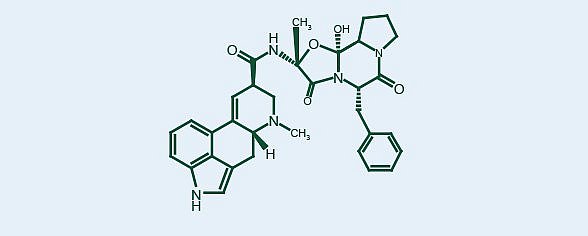Повернутися до бібліотеки Ромера
What are Ergot Alkaloids?

Ergot alkaloids are a large group of compounds produced by fungi that attack a wide variety
of grass species, including small grains, during the growing season. These compounds are
chemically divided into the clavine alkaloids, lysergic acids, simple lysergic acid amides and
peptide alkaloids. Two common alkaloids examined for in ergot are ergotamine and ergovaline.
Production and occurrence
The major ergot fungus is Claviceps which produces sclerotia in several grass species with C. purpurea being the most commonly found species. However, C. fusiformis has produced ergot in pearl millet. C. paspali has been associated with problems in Dallis grass poisonings. Ergot does occur in sorghum and is caused by the organism Sphacelia sorghi. While other fungi are also capable of producing ergot alkaloid these are the major species that are producers of ergot in grain.
The entire life cycle of the organism Claviceps is quite complex but for simplicity, this organism and the other fungi mentioned above replace the developing ovaries of the developing seed with hard masses of fungal tissue called sclerotia (sometimes called "Ergots"). The sclerotia are brown to purple-black in color and contain the ergot alkaloids. The fungus gains entry into the host plant from ergots that have been in the soil. The infecting fungal elements are assisted by wind and splashing rain in gaining access to the host plant where the florets are invaded with subsequent development of sclerotia. The fungus uses nutrients from the plant for development of the ergots and biosynthesis of the ergot alkaloids. The ergots are harvested with the grain and if not eliminated by screening or some other process they can end up in feed or food made from the contaminated grain. Ergot is not a storage initiated problem but the ergots can be present in stored grains resulting from harvesting of ergots along with the grain.
Toxicity
Ergotism is one of the oldest known mycotoxicoses with ancient records of its occurrence. One of the most publicized events was the human epidemics produced by ergot in the Middle Ages known as St. Anthony’s fire with symptoms of gangrene, central nervous and gastrointestinal effects. Animals are affected similarly to what has been observed in humans. In swine agalactia has been attributed to ergot alkaloids. The loss of ears and other appendages is a common effect of ergot in animals. Two types of ergotism have been described; gangrenous and convulsive.
The differences may be due to the different kinds of alkaloids present in the ergot as variations in amount and kinds of alkaloids can occur in the ergot (sclerotia). Recent outbreaks have occurred in Ethiopia (1978) where gangrene and loss of limbs occurred and in India (1975) where the effects were more of the nervous type symptoms of giddiness, drowsiness, nausea and vomiting.
Ergometrine was the alkaloid found in the Ethiopian sclerotia and in India the clavine alkaloids agroclavine, elymoclavine, chanoclavine, penniclavine and setoclavine were found. The ergots produced in these two outbreaks were caused by different species of Claviceps. Because some of the ergot alkaloids are vasoconstrictive and have other beneficial pharmacological properties, they have been used therapeutically. In the United States, most of the widely grown tall fescue posesses an endophytic fungus called Neotyphodium coenophialum. This endophyte produces ergovaline, an ergopeptine, which can, if consumed levels are sufficient, produce ergot-like toxicosis in animals grazed on pastures containing the fescue grass (CAST, 2003).
Опубліковано:
Mycotoxin